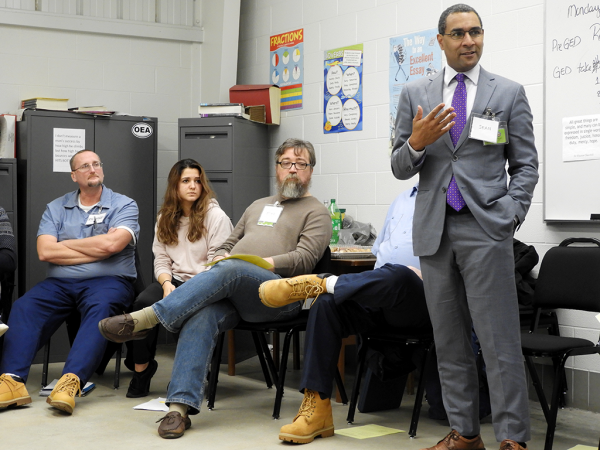Discussing Dickens in Prison

Earlier this month, I visited a Kenyon English class — a fairly typical affair, except that the class was not held on Kenyon’s bucolic campus in Gambier, but rather at the Richland Correctional Institution, a medium-security prison for men in nearby Mansfield.
The class, taught by Assistant Professor of English Kathleen Fernando, was offered as part of the national Inside-Out Prison Exchange Program and enrolled 10 Kenyon students (“outside students”) and 10 prisoners from Richland (“inside students”). Despite its unusual location and course makeup, the class operated as a standard Kenyon seminar, with plenty of reading and writing each week, an emphasis on discussion and close reading of the texts, and a syllabus that included classics by Charles Dickens as well as contemporary novels by authors including Michael Ondaatje and Tayari Jones. Each week the seminar met for a standard three hours (though the “outside” Kenyon students also added about two hours of travel and prison security navigation in their time commitment).
Even for someone like me, a self-described advocate for liberal arts, observing this class in action deepened my appreciation of the power of a liberal arts education experience. The inside students were significantly older than the outside students; their ages ranged from around 30 to 60 years old, and many had already spent 15 or more years in prison. Some inside students had begun college study before making the life decisions that led to their incarceration, including two students who had aspired to be English majors or teachers at earlier points in their lives. All signed up for this course not for credit (Kenyon cannot yet offer courses for credit in the prison), but because they were convinced that the experience of reading and discussing challenging literature would enrich their lives, exercise their minds, and restore their ability to dream and to imagine.
The Kenyon students were faced with some of their biggest challenges for open and rigorous discourse across differences, and they had an experience that challenged many of their assumptions or preconceptions. The diversity of this class was unlike anything they had seen on Kenyon’s campus in Gambier: the “inside” group included students who had converted to fairly conservative Christian or Muslim beliefs while incarcerated; students who were veterans; students who were deeply suspicious of East Coast, cosmopolitan, city-dwellers; students who had experienced severe consequences of racial bias firsthand; and students who were skeptical that racial bias existed. By all accounts, the discussions among the inside and outside students were lively, engaged and characterized by a mutual respect. In fact, the main lesson that both the inside and outside students seemed to take away from this experience was that there is value in listening, engaging and debating across gulfs of difference that may at first glance seem impossible to bridge.
American society is struggling to put a value on the study of the humanities — what is the point of studying literature, of analyzing texts, of engaging in a close read of a poem or a piece of prose? At its core, the humanities challenge us to explore what it means to be human, including our shared values and obligations to one another as well as the differences in how each perceives and understands the world around us. Discussion of literature cultivates empathy, and empathy in turn becomes a foundation for mutual respect and connection across difference. This is just one of the ways that study of the humanities enriches our lives and strengthens all that we do. In our increasingly polarized world, we need this education more than ever.
Photo: Speaking to members of Prof. Fernando’s “In Transit” course at Richland Correctional Institution. (Photo courtesy the Ohio Department of Rehabilitation and Correction)
